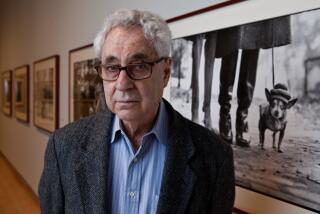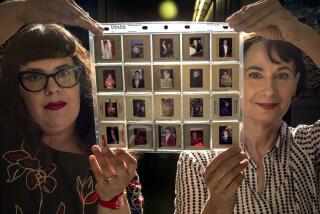B. Abbott, 93; Pioneering Photographer
- Share via
Berenice Abbott, a pioneer photographer best known for her 1930s black-and-white photographs of New York City, has died at 93.
She died Monday of congestive heart failure at her cabin in Monson, Me.
Her work was exhibited as recently as October at the Portland Museum of Art, but she was too ill to attend.
Miss Abbott won critical praise as a photographer whose subjects--people, buildings or scientific phenomena such as the refraction of light through a prism--look at once realistic and artistic.
Her best-known work is “Changing New York,” a published collection of her 1930s photographs. One of the most popular photographs is a black-and-white shot of mid-town Manhattan as seen at night from the top of the Empire State Building.
Born in Springfield, Ohio, on July 17, 1898, Miss Abbott studied briefly at Ohio State University, and went to New York, where she tried journalism, sculpture and acting.
She moved to Paris to study art and fell into photography by accident. She worked as darkroom assistant for American surrealist Man Ray, and he encouraged her to begin taking photographs.
Opening her own studio, she earned her living in the late 1920s as a portrait photographer. One of her most famous works is her 1928 portrait of writer James Joyce.
“Each person was extremely important to me,” she said, discussing her portrait work with Art in America magazine. “I wasn’t trying to make a still life of them, but a person. It’s kind of an exchange between people--it has to be--and I enjoyed it.”
She returned to New York in 1929 and began recording the changing city. She concentrated on the physical structure of the city, aiming her camera upward at bridges or skyscrapers for a novel perspective.
She also began to teach, establishing the photography program at the New School for Social Research. Her photography gradually shifted to science and inventions, where many believe she made her greatest contributions.
Miss Abbott invented equipment that could aid a photographer in creating art. In 1946, for example, she created the Abbott Distorter, which enabled a photographer to make caricatures out of portrait negatives by lengthening a nose or emphasizing a chin.
In addition to publishing collections of her own work, Miss Abbott took photographs to illustrate several science and health textbooks.
She had no survivors.
More to Read
The biggest entertainment stories
Get our big stories about Hollywood, film, television, music, arts, culture and more right in your inbox as soon as they publish.
You may occasionally receive promotional content from the Los Angeles Times.










